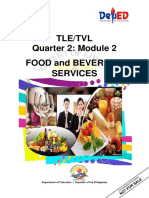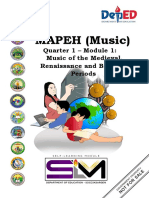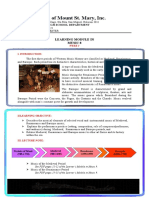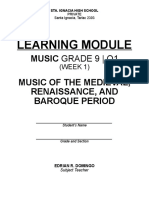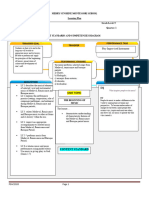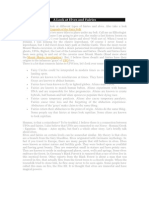Professional Documents
Culture Documents
Music 9 Q1 Las Worksheet No. 1.1 Week 1 2
Music 9 Q1 Las Worksheet No. 1.1 Week 1 2
Uploaded by
Maria Fe VibarOriginal Description:
Original Title
Copyright
Available Formats
Share this document
Did you find this document useful?
Is this content inappropriate?
Report this DocumentCopyright:
Available Formats
Music 9 Q1 Las Worksheet No. 1.1 Week 1 2
Music 9 Q1 Las Worksheet No. 1.1 Week 1 2
Uploaded by
Maria Fe VibarCopyright:
Available Formats
Department of Education
SCHOOLS DIVISION OF CAMARINES SUR
LEARNING ACTIVITY SHEET IN MAPEH 9
Quarter 1 Worksheet no. 1.1 Week 1-2
MUSIC OF THE MEDIEVAL,
RENAISSANCE AND BAROQUE PERIOD
Name of Student:
Learning Area-Grade Level: MUSIC 9
Date:
Medieval, Renaissance, and Baroque era are the early periods of
Western Music History. These periods have distinctive characteristics,
historical and cultural background. The Medieval Era is known for its
Gregorian Chant which is mainly used in the early Christian church. When
Renaissance Period came, music became an important leisure activity that
even members of the upper classes were expected to have musical training.
The distinctive characteristic of Renaissance music is imitative polyphony.
After the flourish of Renaissance period, people were introduced to Baroque
music by the latter. It is known to be characterized by grand and elaborate
ornamentation, not only in music but also in sculptures, theaters, and arts.
This period is known for its music genres namely Concerto, Fugue, Oratorio,
and the Chorale.
At the end of the activities, the learner should be able to:
1. describes the musical elements of selected vocal and instrumental music
of Medieval, Renaissance, and Baroque music; (MU9MRB-Ib-f-5); and,
2. explains the performance practice (setting, composition, role of
composers/performers, and audience) during Medieval, Renaissance,
and Baroque periods; (MU9MRB-Ia-h-2)
Specifically:
a. listens perceptively to selected vocal and instrumental music of
Medieval, Renaissance, and Baroque period;
b. relates Medieval, Renaissance, and Baroque music to its historical and
cultural background
ACTIVITY 1: Medieval, Renaissance, and Baroque music
Address: Freedom Sports Complex, San Jose, Pili, Camarines Sur
Email: [email protected]
Website: www.depedcamsur.com
Telephone No: (telefax) 8713340
1. Listen to the following music.
2. Identify the characteristics of the following songs from Medieval,
Renaissance, and Baroque music according to their musical period. Write
your answer in the provided box.
Note: Audio recordings will be sent to you via messenger, google drive, or you
may use the link below.
Song Musical form Period Characteristics of Music period
1 Liturgy of St. Anthony -
https://www.youtube.com/watch?v=WkjgycIb2J4
2 A l'entrada del temps clar –
https://youtu.be/1fUZwbTOXvA
3 April is in my Mistress' face –
https://youtu.be/o4vE2lZWZVU
4 Concerto Grosso for two violins, cello,
strings, and basso continuo by Handel –
https://youtu.be/-OTDD8lGQvY
ACTIVITY 2.1: Discover and Learn!
1. After listening to the given music in the previous activity, describe the
distinct music changes from the Medieval to Baroque Period.
________________________________________________________________________.
2. Write down important historical events and cultural background that
influences the changes in music in the different periods.
Historical events/Cultural Background Composer/s
Medieval (700-1400)
Renaissance (1400-1600)
Baroque (1685-1750)
Note: For questions number 1 and 2, write your answer on a clean sheet of paper.
Address: Freedom Sports Complex, San Jose, Pili, Camarines Sur
Email: [email protected]
Website: www.depedcamsur.com
Telephone No: (telefax) 8713340
Activity 2.2: Famous composer/s!
Instructions: Provide the necessary answers in each column.
COMPOSER/Year COMPOSITION PERIOD
Adam de la Halle
France, 1237 - 1288
Giovanni Pierluigi da
Palestrina, Rome
1525 - February 2, 1594
Thomas Morley
1557– 1602
Johann Sebastian Bach
Deutschland
March 21, 1685 to July 28,
1750
ASSESSMENT:
A. Instructions: Classify the items in the box according to the historical
period to which it belongs. Write the words in the column below.
Gregorian Chants Fugue Concerto Grosso Invention of compass
Troubadour Music Mass Oratorio Martin Luther’s Protestant reformation
Madrigal Chorale Neumes Cantatas
Medieval Renaissance Baroque
B. Instructions: Choose the letter of the correct answer. Write your answer on your
answer sheet.
1. In what period does Christian Church highly influenced the culture and political
affairs in Europe?
A. Medieval Period
B. Baroque Period
C. Renaissance Period
Address: Freedom Sports Complex, San Jose, Pili, Camarines Sur
Email: [email protected]
Website: www.depedcamsur.com
Telephone No: (telefax) 8713340
2. What is a through-composed vocal music composition that is written and
expressed in a poetic text?
A. Mass
B. Concerto Grosso
C. Madrigal
3. Options below are included in the five main sections of the Mass. Among them
which section is only written in Greek text?
A. Kyrie
B. Agnus Dei
C. Credo
4. What Baroque Musical form is developed through imitative counterpoint?
A. Chorale
B. Fugue
C. Oratorio
5. Oratorio is one of the Baroque Music forms that refers to the extended musical
setting of sacred music.
A. True
B. False
C. Not Sure.
Rubrics for Activity 1 and 2.1
CATEGORY 4 3 2 1 SCORE
CONTENT The output Sufficiently Limited Superficial
has developed, content and/ or
excellent with with minimal
relevance to adequate inadequate content.
the piece elaboration elaboration
that was or or
provided. explanation. explanation
CREATIVITY Work Work is Work Work is
exception- generally somewhat not
ally unique, unique, unique, unique,
detailed, detailed, detailed, or detailed, or
and and interesting interesting
interesting. interesting. shows some and shows
Explores Explores developing no original
several some ideas ideas or
options and options and without a risks
takes many takes some true sense taken.
creative creative of
risks. risks. originality.
Address: Freedom Sports Complex, San Jose, Pili, Camarines Sur
Email: [email protected]
Website: www.depedcamsur.com
Telephone No: (telefax) 8713340
Badiola, M.G., Vecino M.A., et al. First Edition 2014. Grade 9 Learner’s Materials
Music and Arts “A Journey Through Western Music and Arts.” Metro Manila,
Philippines. Vibal Group, Inc.
http://www.depednegor.net -> music_9_tg_draft_4.7.2014.pdf
Prepared by:
JORDAN P. HERNANDEZ, TI, CALABANGA NHS, SDO Camarines Sur
Quality Assured by:
JOYCE D. FESICO, TIII, Baao NHS, , SDO Camarines Sur
JERWIN C. AVENIDO, TI, Sta. Lutgarda NHS, SDO Camarines Sur
JOANA MARIE O. YOCAMPO, PDO II, SDO Cam. Sur
Validated by:
DAN S. ANADILLA, TIII, Sta. Lutgarda NHS, SDO Camarines Sur
IAN JOSEPH VELASCO, TI, Bagacay NHS, SDO Camarines Sur
Layout Artist: EUGENE T. ABRAGAN, T II, Sagorong HS, SDO, Cam. Sur
Reviewed by: IMELDA A. NARDO, EPS 1, SDO CAM. SUR
Address: Freedom Sports Complex, San Jose, Pili, Camarines Sur
Email: [email protected]
Website: www.depedcamsur.com
Telephone No: (telefax) 8713340
LEARNING REFERENCE MATERIAL: Quarter 1 Worksheet no. 1.1 Week 1-2
Music of the Medieval Period (700 – 1400)
This period is also known as the Middle Ages or Dark Ages. During this time,
the Christian Church has high influenced in Europe’s culture and political affairs.
Monophonic plainchant or also known as Gregorian Chant was named after Pope
Gregory I, who made this as an official music of the Catholic Church. His action
made monophonic plainchants popular. Originally these chants are transmitted
orally, but eventually scholars of this time agreed to put it into notation called
Neumes to help in the distribution of chants across Europe. Gregorian Chant as we
basically known is the music of the church that flourished in the Medieval Period. It
was literally born in the church’s liturgy and its text are written in Latin and almost
entirely scriptural. This chant was sung in a pure melody, in unison (which make it
monophonic), and without accompaniment. Gregorian chant is modal and are using
free rhythm, without meter or time signature. One of the famous composers of this
era is Adam de la Halle.
Adam de la Halle (France, 1237 – 1288). Adam was also known as Adam le Bossu
(Adam the Hunchback). His father was a well–known citizen of Arras, named Henri
de la Halle. He studied at the Cistercian Abbey of Vaucelles and considered as one
of the oldest secular composers. Adam was a French-born trouvére, a poet, and a
musician. His literary and musical works include chansons and Jeux-partis (poetic
debates). Most of his style is associated by trouveres, polyphonic rondel, and motets
in the style of early liturgical polyphony. Jeu de Robin et Marion, one of Adam’s
musical play, was considered the earliest surviving secular French play. His other
work also includes “La Chanson du roi de Sicile”
In the latter part of the Medieval Period, secular music which has no relation
to the Catholic traditions emerged. Songs of secular music were mostly performed
by troubadours, a group of musicians, who travelled across Europe.
Music of the Renaissance Period (1400 – 1600)
Renaissance which means rebirth, revival and rediscovery is the period
where chorale music flourished. In this period music was freed from medieval
constraints specifically in range, rhythm, harmony, form, and notation. Mass is a
form of sacred musical composition in this era that sets texts of the Eucharistic
liturgy into music. It has five (5) main sections; the “Kyrie (Lord Have Mercy)”,
“Gloria (Glory to God in the Highest)”, “Credo (I Believe in One God)”, “Sanctus and
Benedictus (Holy, holy, and Blessed Is He)”, and “Agnus Dei (Lamb of God)”. Mass is
characterized as polyphonic, can be sung in a cappella or with orchestral
accompaniment, and its text may be syllabic or melismatic. The Chanson and
Madrigal, both secular forms, are also popular in this era that spread throughout
Europe. Madrigal is a secular vocal polyphonic music composition that originated in
Italy and considered as most important secular music of this era. It is written and
expressed in a poetic text and sung during courtly social gatherings. The prominent
instrument of this era is Lute. Other instruments are also developed in this era
because of the evolution of musical ideas occurred.
Music also became more self-sufficient with its availability in printed form
because of the invention of printing in the 1400’s. With the emergence of the social
class (or also known as “bourgeois class”), renaissance music became popular for
Address: Freedom Sports Complex, San Jose, Pili, Camarines Sur
Email: [email protected]
Website: www.depedcamsur.com
Telephone No: (telefax) 8713340
entertainment. As the new music genre arose, influence of Roman Catholic Church
started to decline. Though sacred music was still of great importance, secular music
became more prominent in this period. Renaissance period was known as the
golden age for “a capella” choral music.
The characteristics of Renaissance music are mostly polyphonic. Imitation
among voices are very common and the use of word painting in texts and music are
evident. Its melodic lines move in a flowing manner in which it is made easier to
perform because its only move along a scale with a few large leaps.
Some famous composers of this time are Giovanni Pierluigi da Palestrina
and Thomas Morley. One of Palestrina’s work is “Pope Marcellus Mass” and Morley’s
works are “Fire, Fire, My Heart, Sing and Chant It, Fantasie, April Is In My Mistress‟
Face”, and It Was A Lover and His Lass.”
“Other historical facts during this era is the discovery of the actual position of earth in
the solar system by Copernicus, the invention of compass creating a wider navigation
not only of the lands but also of the oceans, and Martin Luther’s Protestant
reformation.”
Music of the Baroque Period (1685 – 1750)
Baroque derived from the Portuguese word “barroco” which means “pearl of
irregular shape”. The Baroque music began in Italy. It expanded throughout Europe
because of its composers like Johann Sebastian Bach and George Frideric Handel
whose works have great influence in this era. Some of Bach’s composition includes
Brandenburg Concertos (concerto grosso), Mass in B minor, Cantata 208 and 211,
Fugue in G minor, and Well-Tempered Clavier. One of the famous compositions of
Handel is the Messiah. Bach and Handel together with other German composers
like Georg Philipp Telemann, Michael Praetorius, and Johann Pachelbel are most
influential in this time. Italian Baroque composers of this era which also partake in
the development of Baroque music were Alessandro Scarlatti, Antonio Corelli,
Claudio Monteverdi and Antonio Vivaldi. During this time, Baroque music is
characterized with grandiose and elaborate ornamentation that were clearly seen
and heard in the musical compositions created by these composers. Primarily it has
contrapuntal textures with some homophony and melodies of Baroque music are
not easy to sing or remember. Its music also has dynamic contrast (alternation
between loud and soft). Regarding in the musical instruments of this era,
harpsichord and organ are the keyboard instruments that are commonly used.
In musical notation, new instrumental techniques and changes are also
developed. When it comes to tonality, Major and minor tonality was also created.
Additional musical terms and concepts which evolved in this period were still used
in the present time.
New forms of Baroque music are binary – AB, ternary – ABC, ground bass
and fugue. Other music genre of this time is Concerto, Concerto Grosso, Oratorio,
and Chorale. Concerto is a form of orchestral music that employs a solo instrument
accompanied by an orchestra while the Concerto Grosso is also an orchestral music
of the same era wherein the music is between a small group of solo instruments
called concertino and the whole orchestra called “tutti”. Next is Oratorio, a large-
scale musical composition, both for orchestra and voices, that includes narratives
Address: Freedom Sports Complex, San Jose, Pili, Camarines Sur
Email: [email protected]
Website: www.depedcamsur.com
Telephone No: (telefax) 8713340
on religious themes. And lastly Chorale, a musical composition that resemble a
harmonized version of hymnal tunes of the Protestant Church during the Baroque era.
The end of Baroque period falls on the death of Johann Sebastian Bach in
1750 which also the marked of the new era in music.
Reference:
http://www.depednegor.net -> music_9_tg_draft_4.7.2014.pdf
https://www.giamusic.com/sacred_music/chant_what_is.cfm
https://wmich.edu/mus-history/TheoryHelp/basicforms.gif
https://courses.lumenlearning.com/musicappreciation_with_theory/
chapter/renaissance-music/
https://www.masterclass.com/articles/baroque-era-music-guide#about-
the-baroque-period-of-music
https://www.gramophone.co.uk/features/article/top-10-baroque-
composers-updated-2021
https://www.britannica.com/biography/George-Frideric-Handel
https://www.udiscovermusic.com/classical-features/best-handel-works-10-
essential-pieces/
Address: Freedom Sports Complex, San Jose, Pili, Camarines Sur
Email: [email protected]
Website: www.depedcamsur.com
Telephone No: (telefax) 8713340
ANSWER KEY
Activity 1:
Song Musical form Period Characteristics of Music period
1 Liturgy of St. Anthony - Gregorian - Medieval -Monophonic
https://www.youtube.com/watch? Chant -Free meter
v=WkjgycIb2J4 -Modal
-Usually based on the
liturgy
- Use of Neumes notation
2 A l'entrada del temps clar – - Trouvador - Medieval - Usually monophonic
https://youtu.be/1fUZwbTOXvA Music - Sometimes with improvised
accompaniment
- Tells of chivalry and courtly
love
- Originated in France
- Written in the French
language
3 April is in my Mistress' face – - Madrigal Renaissance - Polyphonic
https://youtu.be/o4vE2lZWZVU - Sung a cappella
- Through–composed
- Frequently, in 3 to 6 voices
4 Concerto Grosso for two violins, -Concerto - Baroque - Melodies sound elaborate
cello, strings, and basso continuo Grosso and ornamental
by Handel – - Melodies are not easy to
https://youtu.be/-OTDD8lGQvY sing or remember
- Primarily contrapuntal
textures with some
homophony
- Dynamic contrast – the
alternation between loud and
soft
- Music genres—operas,
oratorios, suites, tocatas,
concertó grosso, fugue
- Orchestra consists of
strings and continuo
- Harpsichord and organ are
the keyboard instruments
that are commonly used
Address: Freedom Sports Complex, San Jose, Pili, Camarines Sur
Email: [email protected]
Website: www.depedcamsur.com
Telephone No: (telefax) 8713340
Activity 2.2: ANSWER KEY
COMPOSER/Year COMPOSITION PERIOD
Adam de la Halle - Le Jeu de Robin et de Marion Medieval
France, 1237 – 1288 - La Chanson du roi de Sicile
Giovanni Pierluigi da - Palestrina’s Pope Marcellus Mass Renaissance
Palestrina
Rome
1525 - February 2, 1594
Thomas Morley - Fire, Fire, My Heart Renaissance
- Sing and Chant It
1557– 1602 - Fantasie
- April Is In My Mistress‟ Face
- It Was A Lover and His Lass
Johann Sebastian Bach - Brandenburg Concertos (concerto Baroque
Germany grosso)
March 21, 1685 to July 28, - Mass in B minor
- Cantata 208 and 211
1750
- Fugue in G minor
- Well-Tempered Clavier
Address: Freedom Sports Complex, San Jose, Pili, Camarines Sur
Email: [email protected]
Website: www.depedcamsur.com
Telephone No: (telefax) 8713340 |
You might also like
- Success Advanced Student's BookDocument161 pagesSuccess Advanced Student's BookFilip Bozovic86% (14)
- TLE TVL - G9 G12 - Q2 - Module 2 - FBS - Week 2 - Taking Food and Beverage Orders Liases Between Kitchen and Dining AreaDocument27 pagesTLE TVL - G9 G12 - Q2 - Module 2 - FBS - Week 2 - Taking Food and Beverage Orders Liases Between Kitchen and Dining AreaMaria Fe Vibar87% (15)
- TLE TVL - G9 G12 - Q2 - Module 2 - FBS - Week 2 - Taking Food and Beverage Orders Liases Between Kitchen and Dining AreaDocument27 pagesTLE TVL - G9 G12 - Q2 - Module 2 - FBS - Week 2 - Taking Food and Beverage Orders Liases Between Kitchen and Dining AreaMaria Fe Vibar87% (15)
- TVL SHS DRESSMAKING 11 - Q2 - Module 1 ASSEMBLE SLEEPING GARMENTS PARTSDocument39 pagesTVL SHS DRESSMAKING 11 - Q2 - Module 1 ASSEMBLE SLEEPING GARMENTS PARTSMaria Fe Vibar100% (29)
- Boner Stores: Ken SummersDocument48 pagesBoner Stores: Ken SummersShane Erasmus50% (10)
- Music 9: Guided Learning Activity SheetsDocument15 pagesMusic 9: Guided Learning Activity SheetsIan Santos B. SalinasNoch keine Bewertungen
- Eng 7 Q2 Module 1 REVISEDDocument15 pagesEng 7 Q2 Module 1 REVISEDMaria Fe Vibar100% (1)
- SLM Number 1 - Grade 7 Science-2nd Quarter-Parts and Functions of The Compound MicroscopeDocument20 pagesSLM Number 1 - Grade 7 Science-2nd Quarter-Parts and Functions of The Compound MicroscopeMaria Fe Vibar93% (29)
- SLM Number 4-Grade 7 Science - 2nd-Quarter - Plant - and - Animalcell-2Document16 pagesSLM Number 4-Grade 7 Science - 2nd-Quarter - Plant - and - Animalcell-2Maria Fe Vibar100% (5)
- Technical Vocational Livelihood: Department of Education - Republic of The PhilippinesDocument23 pagesTechnical Vocational Livelihood: Department of Education - Republic of The PhilippinesMaria Fe Vibar100% (7)
- TVL SHS DRESSMAKING 12 Q2 Module 1 DRAFT AND CUT PATTERN FOR LADIES BLOUSEDocument49 pagesTVL SHS DRESSMAKING 12 Q2 Module 1 DRAFT AND CUT PATTERN FOR LADIES BLOUSEMaria Fe Vibar92% (12)
- Escape From ParadiseDocument217 pagesEscape From Paradiseisa1381Noch keine Bewertungen
- Airbrush Step by Step - January-March 2015Document72 pagesAirbrush Step by Step - January-March 2015Bob100% (5)
- Flow Like Water For OrchestraDocument36 pagesFlow Like Water For OrchestraSamuel Ricardo LugoNoch keine Bewertungen
- q1 Music 9 Las Melc 5Document6 pagesq1 Music 9 Las Melc 5Janine JavierNoch keine Bewertungen
- Grade 9 Music Module 2020Document19 pagesGrade 9 Music Module 2020Michael Gutierrez dela Pena100% (1)
- Department of Education: Mapeh 9Document33 pagesDepartment of Education: Mapeh 9Cristal Bero100% (2)
- Module 5 Lesson 1Document5 pagesModule 5 Lesson 1rheman pilanNoch keine Bewertungen
- SxeiDocument15 pagesSxeiRodrigl BaiganNoch keine Bewertungen
- Melc No. 1 - Describes The Musical Elements of Selected Vocal andDocument13 pagesMelc No. 1 - Describes The Musical Elements of Selected Vocal andAira RamirezNoch keine Bewertungen
- Music: Quarter 2, Wk. 1 - Module 1Document10 pagesMusic: Quarter 2, Wk. 1 - Module 1Row KneelNoch keine Bewertungen
- G9 Week 5 Music SLMDocument23 pagesG9 Week 5 Music SLMSF• JCBLNoch keine Bewertungen
- Music 9Document24 pagesMusic 9Soliel RiegoNoch keine Bewertungen
- 9 Music LM - Mod.1.v1.0Document33 pages9 Music LM - Mod.1.v1.0Daniel Diaz100% (1)
- 2.ed Music9 q1 Mod2 Music of Medieval Renaissance and Baroque PeriodDocument28 pages2.ed Music9 q1 Mod2 Music of Medieval Renaissance and Baroque PeriodChianlee Carreon100% (1)
- First Quarter Music 9 Learners Module For Online ClassDocument25 pagesFirst Quarter Music 9 Learners Module For Online ClassJaysonMananquilLabsan100% (1)
- Learning Plan Mapeh 9 1st QuarterDocument38 pagesLearning Plan Mapeh 9 1st QuarterCamela Rose CabahugNoch keine Bewertungen
- Music9 - q1 - Mod1 - Vocal and Instrumental Music of Medieval, Renaissance and Baroque Periods - v3Document7 pagesMusic9 - q1 - Mod1 - Vocal and Instrumental Music of Medieval, Renaissance and Baroque Periods - v3Sherly LoricaNoch keine Bewertungen
- forRTP Q1 MUSIC 9 LAS MELC 2 EditedDocument6 pagesforRTP Q1 MUSIC 9 LAS MELC 2 EditedKaitlynne Mae GamboaNoch keine Bewertungen
- Learning Plan Mapeh 9 1st QuarterDocument24 pagesLearning Plan Mapeh 9 1st QuarterMariapaz Colindres CantilanNoch keine Bewertungen
- Simplified Learning Module With Teacher-Made Learner'S Home TaskDocument25 pagesSimplified Learning Module With Teacher-Made Learner'S Home TaskDemuel Montejo100% (1)
- Lesson Exemplar MUSIC10 LESSON 2Document4 pagesLesson Exemplar MUSIC10 LESSON 2alvin taganas100% (1)
- DLP W1 MusicDocument2 pagesDLP W1 MusicTeresa_515Noch keine Bewertungen
- DLP d3 MusicDocument3 pagesDLP d3 MusicTeresa_515Noch keine Bewertungen
- Mapeh 9 Curriculum MapDocument10 pagesMapeh 9 Curriculum MapJoshua LamzonNoch keine Bewertungen
- Week 1 Mapeh 9 - MusicDocument22 pagesWeek 1 Mapeh 9 - MusicEdrian Domingo100% (1)
- Contemporary Arts Quarter 2 WEEK 1Document6 pagesContemporary Arts Quarter 2 WEEK 1John Brylle UrsuaNoch keine Bewertungen
- Unit-Learning-Plan-Music 9Document11 pagesUnit-Learning-Plan-Music 9Clarenz MarcosNoch keine Bewertungen
- Grade 10 Music LASDocument26 pagesGrade 10 Music LASMelanie RaymundoNoch keine Bewertungen
- Lesson Plan in Music - 9Document4 pagesLesson Plan in Music - 9LOURD GINA JUANICONoch keine Bewertungen
- Music 9 Q2 WK6-7Document3 pagesMusic 9 Q2 WK6-7Rojegarmil LagoNoch keine Bewertungen
- Dll-Music Q1Document2 pagesDll-Music Q1Myra Ramirez JulianNoch keine Bewertungen
- Curriculum Map in Music 9: St. Elijah Christian Institute of Technology Foundation, Inc. Ocana, Carcar City, CebuDocument30 pagesCurriculum Map in Music 9: St. Elijah Christian Institute of Technology Foundation, Inc. Ocana, Carcar City, CebuCloue Faye I. Basallo100% (1)
- Curriculum-Map-MAPEH 9Document10 pagesCurriculum-Map-MAPEH 9Janine EstacioNoch keine Bewertungen
- Week 1 Mapeh 10 - MusicDocument12 pagesWeek 1 Mapeh 10 - MusicEdrian Domingo0% (1)
- Music: Quarter 2 - Module 1: Music of The Classical PeriodDocument16 pagesMusic: Quarter 2 - Module 1: Music of The Classical PeriodFrancisco Manabat100% (2)
- Music: Quarter 1 - Module 1a: Music of Medieval, Renaissance and Baroque PeriodDocument16 pagesMusic: Quarter 1 - Module 1a: Music of Medieval, Renaissance and Baroque PeriodBaltazar MagdayaoNoch keine Bewertungen
- Music 9 Quarter 1 - 4Document79 pagesMusic 9 Quarter 1 - 4Jessieann Balmaceda CabanganNoch keine Bewertungen
- Week 1.1 Music 9Document23 pagesWeek 1.1 Music 9Jonell BigleteNoch keine Bewertungen
- MAPEH 8 Lesson Plan Music 2Document3 pagesMAPEH 8 Lesson Plan Music 2Kathleen Claire Galua RamaNoch keine Bewertungen
- Learning Plan - ARTS-9Document5 pagesLearning Plan - ARTS-9Cloue Faye I. BasalloNoch keine Bewertungen
- Lesson Plan Member/s In-Charge: KATHERINE G. ENCABO: Transfer GoalDocument19 pagesLesson Plan Member/s In-Charge: KATHERINE G. ENCABO: Transfer GoalKatherine Pagas GalupoNoch keine Bewertungen
- MAPEH-9 Q1 W1 Mod1Document31 pagesMAPEH-9 Q1 W1 Mod1Rad Karol CastroNoch keine Bewertungen
- CM-9 (Music-1)Document8 pagesCM-9 (Music-1)mike demataNoch keine Bewertungen
- Music Q1-M1Document5 pagesMusic Q1-M1Jun Greg MaboloNoch keine Bewertungen
- Lesson Exemplar MUSIC10 Lesson 1 2022 2023Document5 pagesLesson Exemplar MUSIC10 Lesson 1 2022 2023alvin taganasNoch keine Bewertungen
- G9 Music LM Quarter 1 To 4Document140 pagesG9 Music LM Quarter 1 To 4Charlene BorladoNoch keine Bewertungen
- 1ST QTR Music GR 9Document8 pages1ST QTR Music GR 9Gellai GutierrezNoch keine Bewertungen
- Lesson Plan Music 9Document4 pagesLesson Plan Music 9Shamaica SurigaoNoch keine Bewertungen
- Music 9 Unit PlanDocument2 pagesMusic 9 Unit PlanMa. Sharona OgkingNoch keine Bewertungen
- Music 9 - q1-w3-5 - ClasDocument9 pagesMusic 9 - q1-w3-5 - Clasveldora.storm.dragon99Noch keine Bewertungen
- Music9 - SLAS 1 - Music of Medieval, Renaissance, and Baroque PeriodDocument25 pagesMusic9 - SLAS 1 - Music of Medieval, Renaissance, and Baroque PeriodBryanJAbulocNoch keine Bewertungen
- Vocal and Instrumental Music of Medieval, Renaissance and Baroque PeriodsDocument11 pagesVocal and Instrumental Music of Medieval, Renaissance and Baroque PeriodsJan SolisNoch keine Bewertungen
- MAPEH 5 1stDocument23 pagesMAPEH 5 1stJearlie Mae BasergoNoch keine Bewertungen
- Music9 Q1 W1Document13 pagesMusic9 Q1 W1aurorakleshbNoch keine Bewertungen
- 1 - MU9MRB Ic F 3.1Document2 pages1 - MU9MRB Ic F 3.1Ahra SoNoch keine Bewertungen
- Arts MAPEH10 Week 1Document6 pagesArts MAPEH10 Week 1Klean Rose BorbonNoch keine Bewertungen
- Music Learner'S Material Grade 9 Unit 1: To The IllustratorDocument10 pagesMusic Learner'S Material Grade 9 Unit 1: To The IllustratorCESHNoch keine Bewertungen
- LP 3 Music Q3Document6 pagesLP 3 Music Q3Hazel Rubas Samson100% (1)
- MUSIC Quarter 1 Module 1Document9 pagesMUSIC Quarter 1 Module 1eonaarwen camorroNoch keine Bewertungen
- Mapeh 9 Q2 W1 GlakDocument16 pagesMapeh 9 Q2 W1 GlakPrincess Dirk Reyes DananNoch keine Bewertungen
- Mapeh: Music - Arts - Physical Education - HealthDocument16 pagesMapeh: Music - Arts - Physical Education - HealthManwa Lover100% (1)
- How to Listen to and Understand Opera (Transcript)From EverandHow to Listen to and Understand Opera (Transcript)Rating: 4.5 out of 5 stars4.5/5 (15)
- Add DotsDocument2 pagesAdd DotsMaria Fe VibarNoch keine Bewertungen
- Festival Dance Lesson - Module 2 - P.E. 3rd Quarter PPT 2 of 2Document29 pagesFestival Dance Lesson - Module 2 - P.E. 3rd Quarter PPT 2 of 2Maria Fe VibarNoch keine Bewertungen
- Add Zero 99Document2 pagesAdd Zero 99Maria Fe VibarNoch keine Bewertungen
- Add Zero 99Document2 pagesAdd Zero 99Maria Fe VibarNoch keine Bewertungen
- LP Math Q1 W1 BroquezaDocument14 pagesLP Math Q1 W1 BroquezaMaria Fe VibarNoch keine Bewertungen
- Sub DotsDocument2 pagesSub DotsMaria Fe VibarNoch keine Bewertungen
- LP Math Q1 W2 AmparoDocument6 pagesLP Math Q1 W2 AmparoMaria Fe VibarNoch keine Bewertungen
- Arts LAS Week 1-3 Quarter 1Document10 pagesArts LAS Week 1-3 Quarter 1Maria Fe VibarNoch keine Bewertungen
- WHLP - Mapeh 9 Cot 1Document6 pagesWHLP - Mapeh 9 Cot 1Maria Fe VibarNoch keine Bewertungen
- Eng 7 q2 Module 3 RevisedDocument20 pagesEng 7 q2 Module 3 RevisedMaria Fe Vibar100% (1)
- Eng 7 Q2 Module 2 REVISEDDocument10 pagesEng 7 Q2 Module 2 REVISEDMaria Fe Vibar100% (1)
- SLM Number 3-Grade7 Science 2nd-Quarter-Levels-ofBiological-OrganizationDocument18 pagesSLM Number 3-Grade7 Science 2nd-Quarter-Levels-ofBiological-OrganizationMaria Fe Vibar100% (3)
- Science 8: Earthquakes and FaultsDocument28 pagesScience 8: Earthquakes and FaultsMaria Fe Vibar100% (6)
- HUMSS-CWMODULE1 OkDocument37 pagesHUMSS-CWMODULE1 OkMaria Fe Vibar100% (1)
- TVL SHS DRESSMAKING 12 Q2 Module 2 PREPARE AND CUT MATERIALS FOR LADIES BLOUSEDocument26 pagesTVL SHS DRESSMAKING 12 Q2 Module 2 PREPARE AND CUT MATERIALS FOR LADIES BLOUSEMaria Fe Vibar100% (4)
- Tle/Tvl Quarter 2: Module 1 Food and Beverage Services: Department of Education - Republic of The PhilippinesDocument17 pagesTle/Tvl Quarter 2: Module 1 Food and Beverage Services: Department of Education - Republic of The PhilippinesMaria Fe Vibar100% (13)
- Tle/Tvl Quarter 2: Module 1 Food and Beverage Services: Department of Education - Republic of The PhilippinesDocument17 pagesTle/Tvl Quarter 2: Module 1 Food and Beverage Services: Department of Education - Republic of The PhilippinesMaria Fe Vibar100% (13)
- TVL Dressmaking 2: SHS G-I2Document27 pagesTVL Dressmaking 2: SHS G-I2Maria Fe Vibar100% (2)
- HUMSS-CWMODULE3.2 OkDocument19 pagesHUMSS-CWMODULE3.2 OkMaria Fe Vibar83% (6)
- HUMSS-CWMODULE3.1 OkDocument18 pagesHUMSS-CWMODULE3.1 OkMaria Fe Vibar70% (10)
- HUMSS-CWMODULE2.6 OkDocument15 pagesHUMSS-CWMODULE2.6 OkMaria Fe Vibar100% (1)
- HUMSS-CWMODULE3.3 OkDocument14 pagesHUMSS-CWMODULE3.3 OkMaria Fe Vibar89% (9)
- Worksheet in Test Nozzle - DesignDocument177 pagesWorksheet in Test Nozzle - DesignkeviletuoNoch keine Bewertungen
- Payment Successful '470.82: Mobile Jiofiber Business Shop AppsDocument2 pagesPayment Successful '470.82: Mobile Jiofiber Business Shop AppsSisir MohantyNoch keine Bewertungen
- Shift Shop Meal Plan Week 1Document1 pageShift Shop Meal Plan Week 1Brenda AldoNoch keine Bewertungen
- LogDocument2 pagesLogCak MetNoch keine Bewertungen
- Emperor of Culture: Robert I. Burns. S.JDocument20 pagesEmperor of Culture: Robert I. Burns. S.Jsrdjan_stanic_1Noch keine Bewertungen
- RequiemDocument27 pagesRequiemOctovianus RojakNoch keine Bewertungen
- Week 1 - Q2-Esp 9Document26 pagesWeek 1 - Q2-Esp 9Arnoriely CanilaoNoch keine Bewertungen
- Cloud Computing Service Models A Comparative StudyDocument7 pagesCloud Computing Service Models A Comparative StudyasNoch keine Bewertungen
- JVC lt-42z10 LCD TV All Version SCH Ya786Document39 pagesJVC lt-42z10 LCD TV All Version SCH Ya786Matias SchiaviNoch keine Bewertungen
- Deh 1100 MPDocument67 pagesDeh 1100 MPsfreud1Noch keine Bewertungen
- MDA20011-Assignment-1-Duong Nguyen GiangDocument6 pagesMDA20011-Assignment-1-Duong Nguyen Gianggiangdnswh01287Noch keine Bewertungen
- PD15A07BDocument2 pagesPD15A07BTravis HydzikNoch keine Bewertungen
- Antakshari RoundsDocument8 pagesAntakshari RoundsHriday BhowmikNoch keine Bewertungen
- 7 Sequence of ServiceDocument3 pages7 Sequence of ServiceKrystil Mae D BoncolmoNoch keine Bewertungen
- Altec 1628 Mixer ModsDocument2 pagesAltec 1628 Mixer ModsbjoihawkNoch keine Bewertungen
- NikeDocument30 pagesNikesehaj01Noch keine Bewertungen
- Peterborough Victoria Northumberland and Clarington Catholic District School Board Public Sector Salary Disclosure List For 2015Document3 pagesPeterborough Victoria Northumberland and Clarington Catholic District School Board Public Sector Salary Disclosure List For 2015Peterborough ExaminerNoch keine Bewertungen
- Magazine Planning NotesDocument4 pagesMagazine Planning NotesChristopher BellardNoch keine Bewertungen
- Paul 2022 Main Menu Qatar enDocument9 pagesPaul 2022 Main Menu Qatar enNadia NadiaNoch keine Bewertungen
- Audition Repertoire Suggestions 17-18Document6 pagesAudition Repertoire Suggestions 17-18Buckweet789Noch keine Bewertungen
- FilmDocument27 pagesFilmKevin Jay Mendoza MagbooNoch keine Bewertungen
- (18994849 - Physical Culture and Sport. Studies and Research) The Chain Reaction Between The Media and Sport. The Impact of Rule Changes in HandballDocument9 pages(18994849 - Physical Culture and Sport. Studies and Research) The Chain Reaction Between The Media and Sport. The Impact of Rule Changes in HandballDebreczeni JessicaNoch keine Bewertungen
- A Look at Elves and FairiesDocument5 pagesA Look at Elves and FairiesIk El100% (2)
- Descent of The Dolls by Jeffery Conway, Gillian McCain, David Trinidad Book PreviewDocument39 pagesDescent of The Dolls by Jeffery Conway, Gillian McCain, David Trinidad Book PreviewGeoffrey GatzaNoch keine Bewertungen
- Crim P.E 4 Module 7 1Document12 pagesCrim P.E 4 Module 7 1JpAguirreNoch keine Bewertungen

